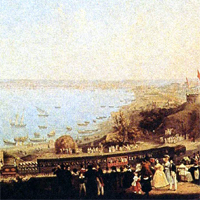Railways and the Making of Italian Unification
Abstract
The making of the Italian unification is strictly connected to the history of railways. Some lines were born few years after the invention of the train, starting with the Napoli-Portici line (1839). There were short and separated sections built independently by each State. Milano- Venezia was the first big railway built in the peninsula, within the Lombard-Veneto Reign belonging to the Austrian Empire.
The improvements of railways in Europe were an indicator of rapid advance of land ways of communication but, at the same time, they enhanced the backwardness of the Italian situation. However, the idea of unification of the peninsula, at least territorial, to be accomplished by a network of railways, was borning for the most far-seeing minds: the matter of railways during the Risorgimento dealt with the creation of the national conscience.
The project for a national network of railways started after the overcoming of the divisions in different states that led to the proclamation of the Kingdom of Italy.
From 1861 to 1865 the constructive effort was considerable. The important line Bologna-Ancona-Foggia, the Roma-Napoli via Cassino, the Roma-Orte-Ancona and the “Porrettana” from Bologna to Firenze were led to the end. Especially important was the period between 1865 and 1885. In 1865 was promulgated the law for the administrative unification of the Kingdom to give an order to railways and, in the same year, the network was divided between four big societies. After the creation of the spine of the country, was the turn of Alps. The first big tunnel was realized in that period: the Cenisio tunnel (finished in 1871). In 1884 the Gottardo tunnel was created, while the Sempione tunnel would have become effective in 1906. Meanwhile the creation of more than 6000 km of secondary railways was financed. The government reorganized in 1885 the Italian railways: the lines were concentrated in two networks disposed lengthwise in the peninsula.
The Conventions had a sixty years long duration divided into three periods of twenty years: the cancellation of contracts was possible at the end of each period. In 1905, the first deadline, the management of railways was adopted by a single State company.
Further interesting things as events concerning steam locomotives, carriages and train stations are connected with the development of the infrastructure. Small and medium-sized train stations laid down in an unique model in the whole nation created a common visual language. Big cities stations designed as architectonic projects that started to be part of urban scenography, intensified on the symbolic plane the role of unification and develop accomplished by railways.
Downloads
References
Benso C (1846), Des Chemins de Fer en Italie,“Revue Nouvelle”, 1° maggio.
Cattaneo C. (1841), La strada ferrata da Milano a Venezia, in “Il Politecnico”, vol. IV, Milano.
Correnti C. (1865),Discorso del deputato Cesare Correnti pronunciato alla Camera dei Deputati nei giorni 4, 5 e 6 aprile sulla discussione del progetto di legge per il riordinamento ed ampliazione delle reti ferroviarie del Regno, in “Rivista dei Comuni italiani”, Firenze, 1865.
Legge 2279 del 14 maggio 1865 “Pel riordinamento ed ampliazione delle strade ferrate del Regno, con la cessione di quelle governative”.
Petitti C.I. (1845), Delle strade ferrate italiane e del migliore ordinamento di esse, cinque discorsi di Carlo Ilarione Petitti, Capolago.

Copyright (c) 2014 Tema. Journal of Land Use, Mobility and Environment

This work is licensed under a Creative Commons Attribution 4.0 International License.
Authors who publish in this journal agree to the following:
1. Authors retain the rights to their work and give in to the journal the right of first publication of the work simultaneously licensed under a Creative Commons License - Attribution that allows others to share the work indicating the authorship and the initial publication in this journal.
2. Authors can adhere to other agreements of non-exclusive license for the distribution of the published version of the work (ex. To deposit it in an institutional repository or to publish it in a monography), provided to indicate that the document was first published in this journal.
3. Authors can distribute their work online (ex. In institutional repositories or in their website) prior to and during the submission process, as it can lead to productive exchanges and it can increase the quotations of the published work (See The Effect of Open Access)
